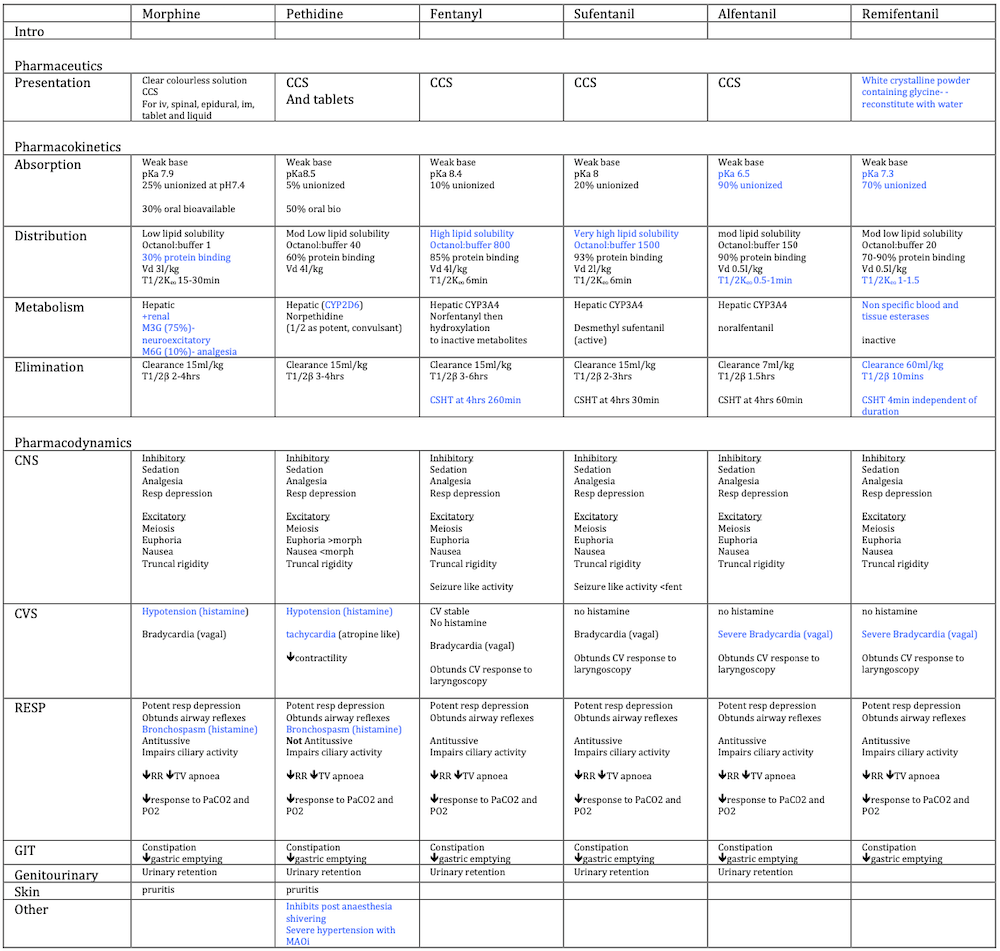Click to download this as a PDF Document
Primary Exam
This gruelling exam is a marathon of mental effort and memory. The level of work to understand and remember such a broad array of topics requires time (about 9-12 months study), discipline and great memory technique (see memory document). Often the content is best organised in tables but this can be very challenging to learn.
In this document I will outline a few tips and tricks to learn the most difficult tables
Take this intimidating opioid table

How do you eat this elephant?
Well the answer is apparently one bite at a time, so let’s use that as a start.
Tip 1: Visual memory is your most powerful memory
For example pharmaceutics is easy because remembering an image is far easier than remembering just words. So imagine that vial of morphine, 10mg/ml in a clear colourless solution. Fortunately most of the rest are also clear colourless solutions.
Tip 2: Memorise the categories
Frameworks are pervasive throughout medicine and for good reason. Imagine trying to memorise and communicate your assessment without history, examination, investigations. Or trying to remember your CVS/resp exam without inspection, palpation, percussion, auscultation.
Memorising the headings and subheadings for pharmaceutics, pharmacokinetics and pharmacodynamics will be one of the most useful things you memorise for this exam. So take the time to learn:
ADME – absorption, distribution, metabolism and elimination.
Within distribution take the time to learn lipid solubility, protein binding and volume of distribution and so on.
Given an unfamiliar medication, you may just be able to write something (even qualitatively) under each heading to gain a few marks.
Tip 3: Most meds in the same class have very similar profiles
Look at pharmaceutics or any of the pharmacodynamics profiles. All of the opioids have pretty much the same characteristics. So instead of learning 6 different datasets you are really learning just one.
Again harness that visual memory and your past experience. Imagine the CNS, CVS, resp, GI and GU effects of every patient you’ve given an opioid to. It’s not hard to imagine a patient post total knee replacement. His knee bandaged, he’s happily been pressing that morphine PCA. He’s sedated, slightly euphoric with meiotic pupils, and an incredibly low resp rate and you’re constantly being called to help with constipation and urinary retention. It’s a hard imagine to forget!
Tip 4: look for the outlier/the standout/the unique characteristic
For example, look at pKa and unionized fractions. Instead of memorizing each number you can generally say that all of them have low unionized fractions except alfentanil and remifentanil. These 2 are the outliers and probably worth memorizing the values as they impact significantly on their speed of onset.
How about lipid solubility? Yes fentanyl and sufentanil are clear outliers that significantly impact on their use (rapid offset due to redistribution).
So go through the table and highlight all the outliers.
Tip 5: Memorise each category
I confess that I did write these tables out in my spare time. While I was able to recall an incredible number of facts, this was not a great return on investment for the exam. Doing previous MCQs and SAQs will guide you to focus on the medications and facts that require more detailed memorisation without devoting wasted time to facts that aren’t commonly tested.
That said if you want to memorise this table just write it out 20 times. Easy.
An important method is to memorise/write it across each category from left to right. For example I wrote the pKa for all the meds, then moved on to write unionized fractions, then lipid solubility then protein binding and so on.
This allows your brain to compare similar numbers and make links between them. If you were to write down each fact for morphine, then pethidine, then fentanyl and so on, it would take far more time to memorise. Try it out!
Tip 6: Memorise the middle
| Severity | Mean gradient (mmHg) | Aortic valve area (cm2) |
| Mild | <25 | >1.5 |
| Moderate | 25-40 | 1-1.5 |
| Severe | >40 | <1 |
Look at this table for severity of aortic stenosis. Medical disease is often broken up into 3 categories of mild, moderate and severe whether is valve disease, or Child Pugh (A, B, C) in liver disease as just 2 examples.
Instead of memorizing each number in each box, you really just have to remember 25-40 and 1-1.5
These numbers define moderate, so either side must be mild and severe. Easy less data points to remember means better recall.
If you have comments or tips that you use, please let us know!